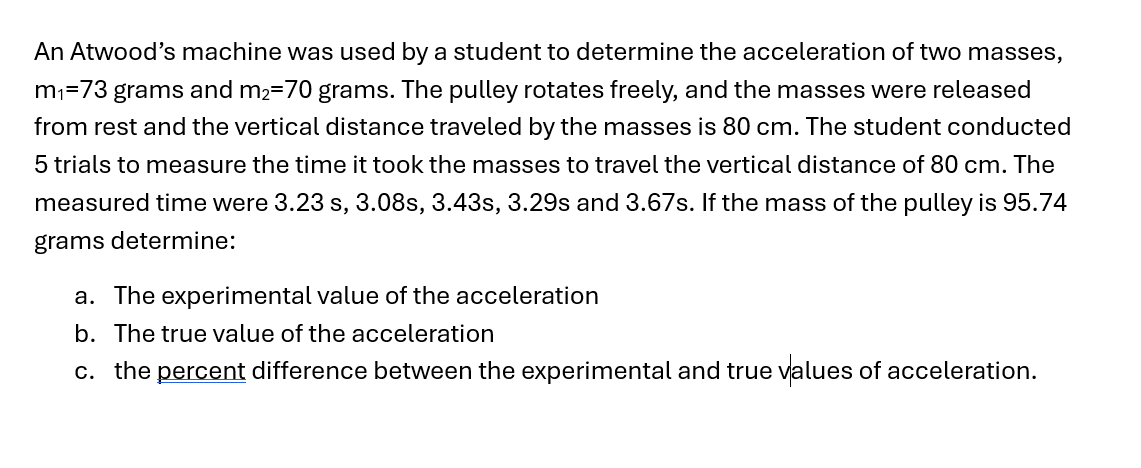An Atwood's machine was used by a student to determine the acceleration of two masses, m₁=73 grams and m2=70 grams. The pulley rotates freely, and the masses were released from rest and the vertical distance traveled by the masses is 80 cm. The student conducted 5 trials to measure the time it took the masses to travel the vertical distance of 80 cm. The measured time were 3.23 s, 3.08s, 3.43s, 3.29s and 3.67s. If the mass of the pulley is 95.74 grams determine: a. The experimental value of the acceleration b. The true value of the acceleration c. the percent difference between the experimental and true values of acceleration.
An Atwood's machine was used by a student to determine the acceleration of two masses, m₁=73 grams and m2=70 grams. The pulley rotates freely, and the masses were released from rest and the vertical distance traveled by the masses is 80 cm. The student conducted 5 trials to measure the time it took the masses to travel the vertical distance of 80 cm. The measured time were 3.23 s, 3.08s, 3.43s, 3.29s and 3.67s. If the mass of the pulley is 95.74 grams determine: a. The experimental value of the acceleration b. The true value of the acceleration c. the percent difference between the experimental and true values of acceleration.
Engineering Fundamentals: An Introduction to Engineering (MindTap Course List)
5th Edition
ISBN:9781305084766
Author:Saeed Moaveni
Publisher:Saeed Moaveni
Chapter8: Time And Time-related Variables In Engineering
Section: Chapter Questions
Problem 39P
Related questions
Question

Transcribed Image Text:An Atwood's machine was used by a student to determine the acceleration of two masses,
m₁=73 grams and m2=70 grams. The pulley rotates freely, and the masses were released
from rest and the vertical distance traveled by the masses is 80 cm. The student conducted
5 trials to measure the time it took the masses to travel the vertical distance of 80 cm. The
measured time were 3.23 s, 3.08s, 3.43s, 3.29s and 3.67s. If the mass of the pulley is 95.74
grams determine:
a. The experimental value of the acceleration
b. The true value of the acceleration
c. the percent difference between the experimental and true values of acceleration.
Expert Solution
This question has been solved!
Explore an expertly crafted, step-by-step solution for a thorough understanding of key concepts.
Step by step
Solved in 2 steps with 6 images

Recommended textbooks for you

Engineering Fundamentals: An Introduction to Engi…
Civil Engineering
ISBN:
9781305084766
Author:
Saeed Moaveni
Publisher:
Cengage Learning

Engineering Fundamentals: An Introduction to Engi…
Civil Engineering
ISBN:
9781305084766
Author:
Saeed Moaveni
Publisher:
Cengage Learning